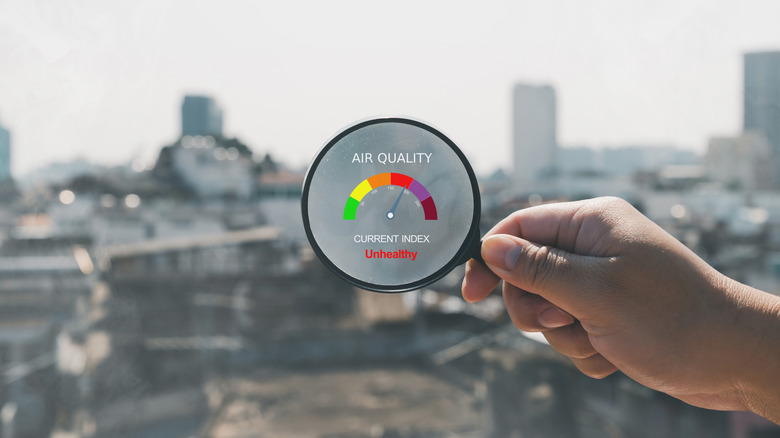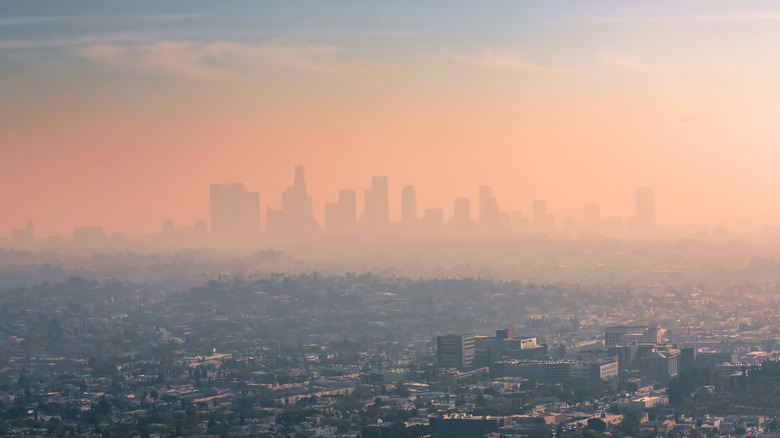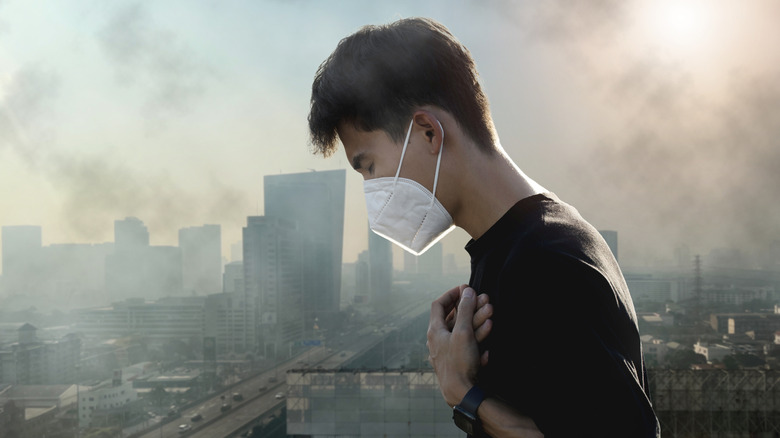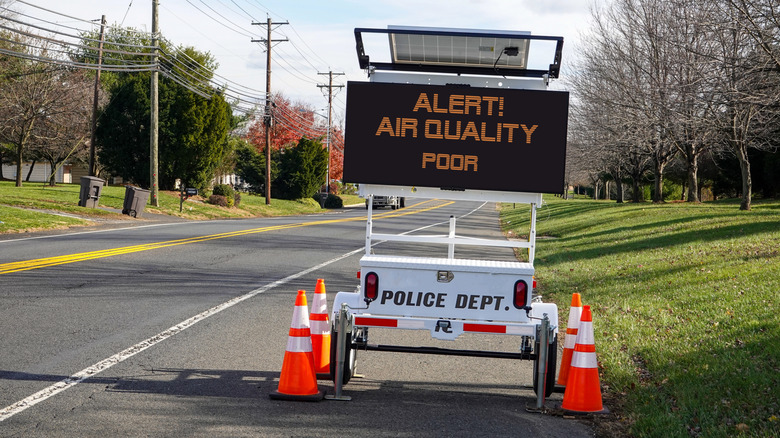What It Means When There's An Air Quality Alert
Air quality is declining steeply in many parts of the United States due to the increasingly extreme effects of our carbon footprint. With this decline comes a growing number of air quality alerts. You'll see them online, on the local news, even on highway signs, but the language they use isn't always clear. You might hear things like, "it's code purple for ozone today," or "code red for particulate matter," and to help make sense of these terms, it's necessary to first define what air quality even is.
In the United States, air quality is measured according to the Environmental Protection Agency's Air Quality Index (AQI), which keeps records for air quality all around the country. To keep the index up to date, every American city with a population of 350,000 or above is required to report air quality data on a daily basis, and many smaller locales also do so voluntarily. These data are captured by air pollution monitors stationed at over 1,000 different locations around the country.
The AQI is a scale ranging from 0–500, with zero representing the cleanest possible conditions, and any number over 300 representing the most severe risk to public health. The AQI scale is also divided into six colors. Values of 0–50 are green, 51–100 are yellow, 101–150 are orange, 151–200 are red, 201–300 are purple, and values over 300 are maroon. Anyone can find the current AQI for their location by visiting the EPA's AirNow website.
What factors determine AQI?
Air quality is determined by measuring five different types of pollutants, singled out by the Clean Air Act. The two at the forefront are ground-level ozone and particulate matter. Ozone is naturally produced in the stratosphere, where it shields Earth from ultraviolet radiation. That's something we can all get behind, but when ozone forms at ground level where we can breathe it in, it can cause a variety of respiratory illnesses. Ground level ozone is mainly produced by fossil fuel emissions, and it is exacerbated by sunlight, making warm summer days the worst time of year for air quality.
Particulate matter (PM) refers to microscopic particles in the air that can get lodged in the lungs if you breathe them in. The most concerning among these are PM2.5, particles that are less than 2.5 micrometers wide. They can come from vehicle emissions, power plants, and fires, but they are too small to see without an electron microscope. For comparison, the width of a human hair is between 50–120 micrometers.
The final three pollutants that factor into the AQI are carbon monoxide, sulfur dioxide, and nitrogen dioxide. These compounds are considered indirect greenhouse gasses, not directly trapping heat themselves, but rather exacerbating the effects of greenhouse gasses on global warming. Nitrogen dioxide and carbon monoxide also contribute to the formation of ozone, which is a direct greenhouse gas, and as previously covered, a key indicator of air quality.
The dangers of bad air quality
So, you know what air quality means, but why should you care about it? The quality of the air you breathe is critical to your quality of life, and consistently breathing in air that contains high levels of greenhouse gasses or particulate matter can have a wide-ranging impact on your health. Lower levels of air pollution typically cause mild effects similar to seasonal allergies such as eye and throat irritation. Consistent exposure to the highest levels of the AQI can lead to more serious consequences like chronic heart and lung conditions.
The World Health Organization specifically cites strokes, lung cancer, pneumonia, chronic obstructive pulmonary disease, and ischemic heart disease as being the conditions most closely linked to air pollutants. All of these conditions can be fatal. Although the most obvious impact of breathing air pollutants is on the lungs, the dangers go far beyond that, specifically when it comes to particulate matter. PM are small enough to cross from the lungs into the bloodstream, spreading throughout your organs and causing systemic cell damage.
Some people are more vulnerable to poor air quality than others, particularly children, elderly people, and pregnant people. In pregnancies, exposure to air pollution can lead to adverse effects on the child, chiefly premature birth and low birth weight. The most vulnerable need to be the most cautious of air quality alerts, so here's what to do when you see one.
What to do when you get an air quality alert
Health alerts are typically issued when a region's AQI score climbs over 200, indicating a potential health risk to all groups. When air quality becomes this poor, your goal should be to avoid outdoor air as much as possible. That means staying inside with all exterior doors and windows sealed shut. If you have an air conditioner, turn it on and keep it running (with the fan on, not on the auto setting). This will force the air entering your house from the outside to pass through the air conditioner's filter. If you live in an area that experiences frequent poor air quality, it would also be wise to get at least one air filter for your home.
It isn't always possible to stay shuttered up with an air filter running, but even if you can't avoid the air pollution, there are steps you can take to minimize your health risk. If you have to be outside, avoid strenuous physical activities to whatever degree you can. Oh, and don't smoke (shocker).
We all got familiar with face masks thanks to COVID-19, and that close relationship is destined to continue with worsening air quality. Face masks are, unfortunately, ineffective at filtering out gasses like ozone and carbon monoxide, but respirator masks with a rating of N-95 or above can protect against PM. Ultimately, though, it will take concrete action on the front of curbing climate change to effectively save us from air quality alerts.



